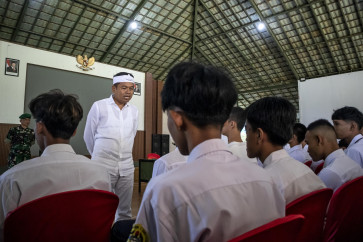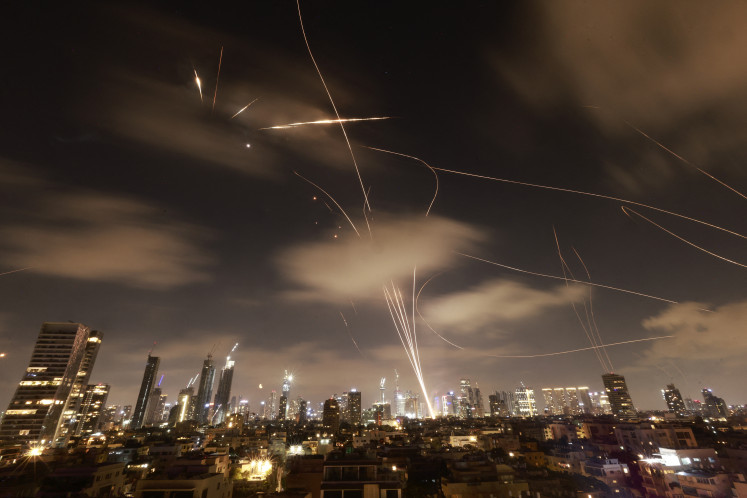Popular Reads
Top Results
Can't find what you're looking for?
View all search resultsPopular Reads
Top Results
Can't find what you're looking for?
View all search resultsLouis Vuitton a fashionable trip down memory lane
Magic trunk: Designer Louis Vuitton got his start by creating trunks, which are still produced to this day
Change text size
Gift Premium Articles
to Anyone

Magic trunk: Designer Louis Vuitton got his start by creating trunks, which are still produced to this day.(JP/Charisa Vanessa)
Iconic fashion label Louis Vuitton celebrates its history in the “Louis Vuitton Time Capsule” exhibition in Jakarta, which also marks the label’s 30th anniversary in Indonesia.
Since its conception 164 years ago in Paris, one of the world’s fashion capitals, renowned fashion label Louis Vuitton has continued to evolve while maintaining its signature Damier brown square patterns and Monogram to this very day.
To celebrate its illustrious history, the “Louis Vuitton Time Capsule” exhibition has arrived in Jakarta to showcase the eponymous brand’s legacy.
Since its inaugural 2017 showing in Hong Kong, the exhibition has visited several cities, including Bangkok, Toronto, Los Angeles and Singapore.
Now at the Senayan City shopping mall in South Jakarta, the free-admission exhibition is running from Oct. 23 to Nov. 11, drawing crowds from all walks of life.
Fashion student Nelly Tantan, who is in her final year of study, visited the exhibition to write a report for a course she is taking and found it to be quite informative on the label’s history. Meanwhile, her friend Naomi Sutono was fascinated on learning about how the brand’s current lines could be traced back to classic pieces.
Another visitor, Bensfica Fidelia Audrey, was impressed upon finding an exhibition that was “carefully crafted to attract younger audiences seeking unique spaces to glorify their social media feeds”.

Visitors are greeted in the Artisans’ Room, the exhibition’s first section, with a live workshop with artisan Jacqueline Servant, who displays her skills in assembling Louis Vuitton’s Petite Malle, a bag that takes about four hours to produce.
A fun fact about the Petite Malle, which means “small trunk” in French, is that even though it was first spotted in the Fall/Winter 2014 women’s collection under creative director Nicolas Ghesquière, the bag’s diminutive shape was inspired by Louis Vuitton trunks, the brand’s staple offering since the mid-19th century.
During the live workshop, visitors can also look at the materials used in creating Louis Vuitton products like the Damier canvas, first created by Vuitton’s son Georges Vuitton to combat forgery in 1888 and which bears the words “marque L. Vuitton déposée”, or “L. Vuitton registered trademark”.
Georges also created the iconic interlocking L-and-V monogram in 1896 to honor his father, who passed away in 1892.
Other materials on display include Epi leather, which was relaunched in 1985, and Taiga leather, launched in 1993 for a men’s collection.
Moving on to “The Key to the Codes” section, visitors can view the design features that make up vintage Louis Vuitton trunks: the durable steel hardware, the distinctively patterned canvas and the Malletage technique, which is still in use.

Archival pieces are on display in the “Journeys around the World” section, with some pieces more than a century old. Interestingly, these pieces are still in remarkably good condition, perhaps a testament to the brand’s build quality.
In 1897, in the days before cars were equipped with a rear storage compartment, Louis Vuitton created the trunks specifically for mounting on the rear of early automobiles, in the very location where modern sedans have trunks.
The French fashion house also created trunks for specific modes of transport, from heavyset trunks for traveling by air to lighter ones for rail travel.
The Steamer bag was introduced in 1901 for those traveling on steamboats, made from leather and small enough to fit inside a Louis Vuitton trunk. Thereon, the Steamer shape has continued to be reintroduced in various iterations.
A variety of Louis Vuitton models in recent history were indeed lifted from archival pieces, including the 1930 Keepall travel bag and the Noé bucket bag of 1932, with the latter originally designed to hold five bottles of champagne.
Most notably, actress Audrey Hepburn was responsible for the Speedy bag, which was created in 1965 upon a request from the legendary actress for a smaller version of the Keepall.

While handbags are arguably Louis Vuitton’s most identifiable offerings, the founding designer started out as the official box maker and packer of France’s Empress Eugenie de Montijo, the wife of Napoleon Bonaparte.
Vuitton’s trunk-making abilities are displayed in the “Elegance in Motion” section, its hallways lined with a variety of trunks custom-made for specific items, including one commissioned by Indonesian actress-turned-businesswoman and Louis Vuitton superfan Lia Candrawati to store her collection of watches.
Along with archival pieces, the exhibition also features reproductions of sketches from the brand’s creative directors as well as advertisements.
A notable reproduction is an article dated July 29, 1988, from Suara Pembaruan daily that heralds the opening of the first Louis Vuitton store in Jakarta at Ratu Plaza, which then-French ambassador Loic Hennekinne officiated.
The brand’s most iconic lines are displayed in the “Icons of the House”, tracing the years from vintage Louis Vuitton to collaborative creations.
One collaborative piece is a limited-edition silk scarf designed by renowned Indonesian artist Eko Nugroho for the Fall/Winter 2013 to 2014 collection. The scarf clearly features Indonesian elements, such as Borobudur Temple, that are combined with pop culture influences.

Those into the streetwear scene will be delighted by the 2017 collaborative pieces with New York’s streetwear brand Supreme: a trunk and skateboard in Supreme’s vibrant red and the LV monogram in white.
In the final section, “Magic Malle”, giant monitors surround a central trunk-shaped monitor that screen a 2-minute history of Louis Vuitton’s beginnings to the massive fashion house it has grown into today.
While many fashion aficionados will appreciate the rare chance to get up close to the brand’s signature vintage pieces, others are certain to appreciate the exhibition for the more contemporary purpose of taking selfies.
At the end of their journey through the “Louis Vuitton Time Capsule”, visitors receive one out of six commemorative postcards as a parting gift, to take home a piece of the grand label’s history with them.









